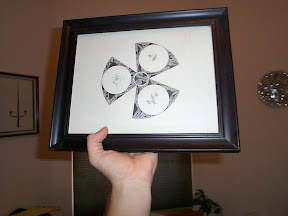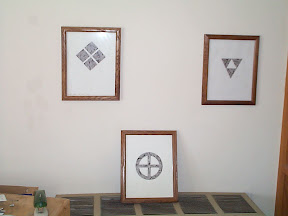Artwork
I do art. A lot of it.
Most of it is written, and most people no longer consider writing art, and I have a tendency to agree with them. Writing is media not, and there isn't much media that's art.
Even the stuff that I eventually plan on publishing, it's not art, it's simply stuff that lives in the back of my mind, day in, day out. Maybe, when I start publishing, the characters that live in me will be able to get some rest.
Jonathan might as well be looking over my shoulder, nodding his head while he munchs on some chips. He's my Tyler Durden, and he knows it.
You know you're a Mary Sue, right Jon? Fast cars, lots of money, and power beyond anyone's ability to comprehend. That's what a Mary Sue has, and so you're a Mary Sue.
Jon wants me to point to another character, he doesn't like to think of himself that way. There is another character that I should accuse of being a Mary Sue, but telling the name would be giving away secrets. That's books away, remember?
Back on the point, I do art. I draw. I can't draw a human figure worth a darn, but I draw all of the same. Someday, someone's going to find the set of 13 panels that I did two years ago in Albuquerque and assemble them. The 3 interior panels are on my wall, but the rest are all over the country. The didn't do what I wanted, but it's still a work of art. Probably one of the largest ones in existence, actually.
There are what, six close panels after that? One went to my old boss Sara. The other five went to family members.
The four outlying panels are the really tough ones. One when to the Dark Amyrlin, one went to the Uncle that I've never met. One went to Isabelle. One went to GEMINI.
I've got copies of them, but the originals are interesting too.
I'm almost done with one. I'm thinking of calling it The 50th Symphony, but that would be pretentious, and possibly insulting. The other working title is The Unfinished Symphony. We'll see which one is more fitting.
The process is something that I love. It's very specific. First is the outline. Always an outline, because I like the way the chaotic interior of the work is offset by the clear and definite lines of the exterior. The outline is done with a pencil, a ruler, and a compass, and usually a triruler as well. Recently, I've been using a circle sheet to create nearly perfect circles, which look nice against the perfectly straight lines.
One the outline is done with pencil, then I trace it with a pen with a superfine nib. This will be the pen that I'll be using for stage 2. Right now, I've only got two Pentel pens that work for this, and so I really want more. The store that I bought them at is in Albuquerque though, and the branch her in S. Fe doesn't carry them.
This part is called fine line, and when I'm doing it, it's religious. It takes a fair bit of concentration, and I used to do it while I was in classes that I didn't like, and now I do it while I'm watching television. Inside the outline, Iwant as little while space as possible while following whatever pattern or rule that I've decided on. It's all very demanding.
It also takes hours. I've put easily 30 to 40 hours into the Symphony already, and I'm only 75% of the way through the fine line work. Probably another full week's work before I start the blocking.
When I'm doing fine line, large black areas waste ink and destroy the fine nibs, so I don't do more than outline them and fill in the corners and small sections during fine line. Blocking is when I go back and fill in the dark spaces. There have been a couple of times when I've seriously considered not doing the blocking at all, leaving the space white, but at this point, I've always filled it in. Experimenting with the blocking is still in my future.
That's when I erase the guidelines. I should use a lighter touch when I draw them, because sometimes they're to dark to cleanly erase, but when I'm done, it looks pretty amazing.
This, of course, would be the perfect time to show you an example of what I do, wouldn't it? But, of course, I don't have an example right now. I was supposed to, but I don't.
So check in the day after tomorrow, and I'll post an example then for you all to see.
UPDATE:
I told you I'd have examples, but I'm not sure how this is going to work, so bear with me. If nothing else, I'll just post links.
Also: forgive the poor quality. I was using an old digital camera, and it doesn't always work great.
This first one is one of the six close panels from the 13 panel set. Yes, it's a picture of an original.

This second one is a picture in my apartment:

And a really lousy detail from the left hand one in the picture above:

Sorry about the blurry nature of the pictures, but you probably get the idea.
Most of it is written, and most people no longer consider writing art, and I have a tendency to agree with them. Writing is media not, and there isn't much media that's art.
Even the stuff that I eventually plan on publishing, it's not art, it's simply stuff that lives in the back of my mind, day in, day out. Maybe, when I start publishing, the characters that live in me will be able to get some rest.
Jonathan might as well be looking over my shoulder, nodding his head while he munchs on some chips. He's my Tyler Durden, and he knows it.
You know you're a Mary Sue, right Jon? Fast cars, lots of money, and power beyond anyone's ability to comprehend. That's what a Mary Sue has, and so you're a Mary Sue.
Jon wants me to point to another character, he doesn't like to think of himself that way. There is another character that I should accuse of being a Mary Sue, but telling the name would be giving away secrets. That's books away, remember?
Back on the point, I do art. I draw. I can't draw a human figure worth a darn, but I draw all of the same. Someday, someone's going to find the set of 13 panels that I did two years ago in Albuquerque and assemble them. The 3 interior panels are on my wall, but the rest are all over the country. The didn't do what I wanted, but it's still a work of art. Probably one of the largest ones in existence, actually.
There are what, six close panels after that? One went to my old boss Sara. The other five went to family members.
The four outlying panels are the really tough ones. One when to the Dark Amyrlin, one went to the Uncle that I've never met. One went to Isabelle. One went to GEMINI.
I've got copies of them, but the originals are interesting too.
I'm almost done with one. I'm thinking of calling it The 50th Symphony, but that would be pretentious, and possibly insulting. The other working title is The Unfinished Symphony. We'll see which one is more fitting.
The process is something that I love. It's very specific. First is the outline. Always an outline, because I like the way the chaotic interior of the work is offset by the clear and definite lines of the exterior. The outline is done with a pencil, a ruler, and a compass, and usually a triruler as well. Recently, I've been using a circle sheet to create nearly perfect circles, which look nice against the perfectly straight lines.
One the outline is done with pencil, then I trace it with a pen with a superfine nib. This will be the pen that I'll be using for stage 2. Right now, I've only got two Pentel pens that work for this, and so I really want more. The store that I bought them at is in Albuquerque though, and the branch her in S. Fe doesn't carry them.
This part is called fine line, and when I'm doing it, it's religious. It takes a fair bit of concentration, and I used to do it while I was in classes that I didn't like, and now I do it while I'm watching television. Inside the outline, Iwant as little while space as possible while following whatever pattern or rule that I've decided on. It's all very demanding.
It also takes hours. I've put easily 30 to 40 hours into the Symphony already, and I'm only 75% of the way through the fine line work. Probably another full week's work before I start the blocking.
When I'm doing fine line, large black areas waste ink and destroy the fine nibs, so I don't do more than outline them and fill in the corners and small sections during fine line. Blocking is when I go back and fill in the dark spaces. There have been a couple of times when I've seriously considered not doing the blocking at all, leaving the space white, but at this point, I've always filled it in. Experimenting with the blocking is still in my future.
That's when I erase the guidelines. I should use a lighter touch when I draw them, because sometimes they're to dark to cleanly erase, but when I'm done, it looks pretty amazing.
This, of course, would be the perfect time to show you an example of what I do, wouldn't it? But, of course, I don't have an example right now. I was supposed to, but I don't.
So check in the day after tomorrow, and I'll post an example then for you all to see.
UPDATE:
I told you I'd have examples, but I'm not sure how this is going to work, so bear with me. If nothing else, I'll just post links.
Also: forgive the poor quality. I was using an old digital camera, and it doesn't always work great.
This first one is one of the six close panels from the 13 panel set. Yes, it's a picture of an original.

This second one is a picture in my apartment:

And a really lousy detail from the left hand one in the picture above:

Sorry about the blurry nature of the pictures, but you probably get the idea.



0 Comments:
Post a Comment
<< Home